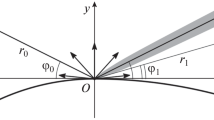Abstract
We consider the diffraction of waves by objects with higher order discontinuities. The geometric theory of diffraction (gtd) diffracted field for this type of discontinuities have strong divergence near normal incidence. We substract from this diffracted field, the field radiated by the Luneberg-Kline currents to get the fringe diffracted field; and show that this field is finite. The formulae can be used to improve the accuracy of physical theory of diffraction (ptd) for smooth objects without edges. Explicit formulas are given for the discontinuity up to order 5. We present a numerical application for the discontinuity in the curvature. All computations are done by using Maple symbolic computation system.
Résumé
On considère la diffraction d’une onde plane électromagnétique par un objet présentant une discontinuité de courbure ou d’impédance d’ordre élevé. Le champ diffracté obtenu par la théorie géométrique de la diffraction (tgd) pour ce type de discontinuité diverge fortement en incidence normale. Les auteurs soustraient à ce champ diffracté, le champ rayonné par les courants de Luneberg-Kline pour obtenir le champ correspondant à l’onde de frange. De plus ils montrent que ce champ est fini. Cette méthode permet d’améliorer la précision de la théorie physique de la diffraction (tpd) pour ce type de discontinuité. Des formules explicites sont présentées pour des discontinuités allant jusqu’à l’ordre 5. Une application numérique pour le cas d’une discontinuité de courbure est présentée. Tous les calculs sont effectués à l’aide du logiciel de calcul formel Maple.
Similar content being viewed by others
References
Kaminetzky (L.), Keller (J. B.). Diffraction coefficients for higher order edges and vertices.SIAM J. Appl. Math. (1972),22, n° 1, pp. 109–124.
Ufimtsev (P.Ya.). Elementary edge waves and the physical theory of diffraction.Electromagnetics (1990), n° 11, pp. 125–160.
Bouche (D.), Molinet (F.). Onde de frange pour une discontinuité de courbure.Ann. Télécommunic. (1991),46, n° 7–8, pp. 388–391.
Bowmna, Senior, Uslenghi. Acoustic and electromagnetic scattering by simple shapes.Hemisphere (1987).
Luneberg (R. M.). Mathematical theory of optics.Brown University Press (1944).
Ivanov (V. I.). Calculation of corrections to geometrical optics I. The scalar problem. (1968), pp. 289–301.
Bouche (D.). Courant sur un obstacle cylindrique parfaitement conducteur présentant une discontinuité de courbure.Ann. Télécommunic. (1992),47, pp. 391–399.
James (G. L.). Geometrical theory of diffraction for electromagnetic waves.IEE Electomagnetic waves series 1 (1986), 293 p., third edition revised.
Constantinides (E. D.), Marhefka (R. J.). A UGO/EUTD solution for the scattering and diffraction from cubic polynomial strips.IEEE Trans. AP (Aug. 1993),41, n° 8, pp. 1088–1098.
Author information
Authors and Affiliations
Rights and permissions
About this article
Cite this article
Montarnal, P., Bouche, D. Fringe wave diffraction coefficients for higher order discontinuities. Ann. Télécommun. 51, 137–142 (1996). https://doi.org/10.1007/BF02995504
Received:
Accepted:
Issue Date:
DOI: https://doi.org/10.1007/BF02995504
Key words
- Electromagnetic wave propagation
- Wave diffraction
- Discontinuity
- Asymptotic approximation
- Curvature
- Cylindrical shape




